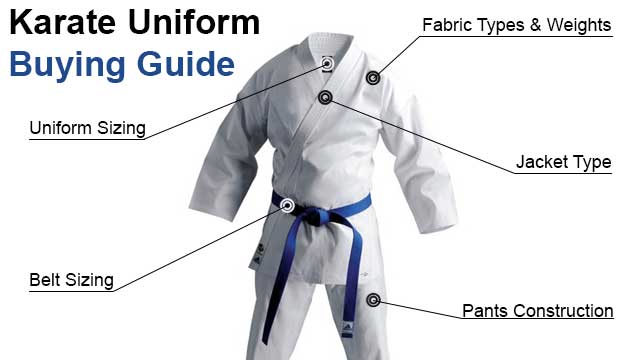
This karate uniform buying guide is intended to aid you in selecting the right uniform for your needs. This is a must read for those purchasing their first uniform either for themselves or their children.
I want to make a quick point on terminology, we use the terms uniform and gi interchangeably. Depending on the school and style they may refer to them either way but they are typically the same thing so there is no need to fret over it.
What makes up a karate uniform:
It consists of a jacket, pants and a belt.
The jacket is a open wrap around style that is secured using ties inside the jacket and a karate belt. It is pretty typical for the jackets to be decorated with patches (generally dictated by the school or origination), and you will often times see black belts with their names screen printed or sewn on to the back.
Example of a Karate Jacket:
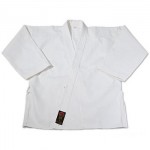 |
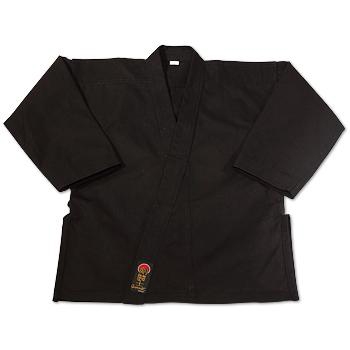 |
The pants have a gusseted crotch that is designed to increase strength of the seam and reduce tearing. This also increases the angle at which the pants can open to a split to aid with performing kicks, stances, stretching, and other training activities.
The waist of the pants can be secured with a traditional tie strap that loops through like a belt or a more modern style elastic waist with a tie string similar to sweat pants. It is really a matter of preference as to what is best, but the elastic waist is typically easier to maintain and use, so it is recommended for kids.
Example of Karate Pants and Waist Type:
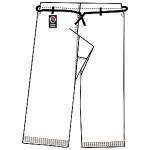 |
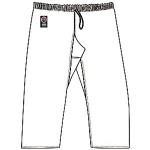 |
Selecting the right fabric type and weight:
The uniforms typically can be found in two fabric types; 100% cotton and a cotton/polyester blend usually consisting of 55%cotton/45% polyester.
100% Cotton – This generally makes up the higher quality medium and heavy weight uniforms. But, they can be more difficult to take care of as they will shrink if washed and dried incorrectly. You will want to wash in cold water and air dry only. You can find them preshrunk, but I generally do not recommend these as your everyday training uniform. It should be limited to competitions and/or as a instructor uniform where it does not have be to be cleaned all the time.
Cotton/Polyester Blend – This fabric type usually makes up your less expensive light and medium weight uniforms. However, it is known to be easier to take care of, and is less susceptible to shrinkage. They generally make great everyday training uniforms and are better for kids.
Fabric Weight:
The uniforms are classified in the following ways:
- Lightweight – 5oz to 6oz
- Medium-weight or middleweight – 7oz to 8.5oz
- Heavyweight – 10oz – 14oz
Some manufactures also have a super heavyweight which is generally 14oz or more.
Lightweight – These generally make up your student uniforms and are typically what you will get as your first uniform if the school provides you a uniform when you sign up for classes. They are the least expensive and usually the least quality of the bunch. However some martial artists prefer these for training because they are cooler and don’t weigh you down.
Recommended Lightweight Uniforms:
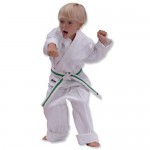 Macho 5oz Ultra Light Weight Karate Uniform |
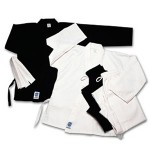 ProForce 5oz Ultra Light Weight Karate Uniform |
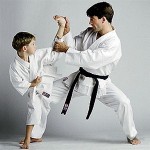 ProForce 6oz Student Karate Uniform |
Medium-Weight – These are my choice for an everyday training uniform as they provide a balance between strength, weight, and coolness. They will generally last longer and hold up better over time than a lightweight uniform. There is also generally a larger selection of sizes and colors in this range from most manufacturers. They can be found in both 100% cotton and the cotton/polyester blend fabrics to fit your preference.
Recommended Medium-Weight Uniforms:
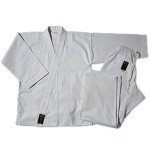 ProForce Gladiator 7.5oz Karate Uniform |
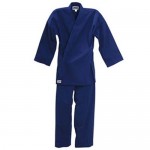 Macho 8.5oz Traditional Karate Uniform |
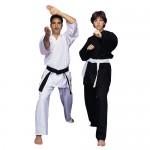 GTMA 100% Cotton Medium Weight Karate Uniform |
Heavyweight – I reserve this range for either a competition, demonstration, or instructor uniform. The heavier weight fabric is a very nice canvas material that has a great snap to it when performing your techniques, which is excellent for kata and performances. They can be found in both fabric types, but the heavier weights typically only come in 100% cotton.
Recommended Heavyweight Uniforms:
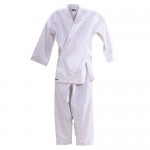 Macho 11oz Traditional Heavyweight Karate Gi |
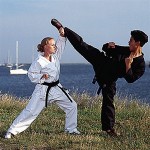 ProForce 12oz 100% Cotton Canvas Karate Gi |
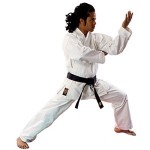 ProForce 14oz 100% Cotton Heavy Weight Canvas Karate Gi |
Quick note about uniform colors:
Generally most schools require white uniforms for lower rank students, and reserve the other colors for the higher rank students and black belts. This is important to keep in mind and find out from your instructor before deciding what color to get. Black is also sometimes required for new students so that is why we recommend that you find this out before hand as it varies from school to school.
Examples of the typical colors:
 |
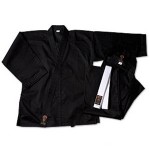 |
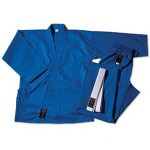 |
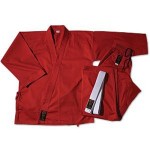 |
Choosing the right size:
Karate gis are typically found in size ranges of 00000 – 8, from smallest to largest.
The sizing charts from most manufacturers relate these sizes to height and weight. In order to get the right size for your body type you need to find your height range in the chart. After you find your height range, look at the corresponding weight range. If your weight is not within that range, continue down the weight column until your weight fits the appropriate range.
In situations where your weight puts you in a larger uniform then your height, your pants are going to be too long and will need to be hemmed up.
If your weight puts you in a smaller size than your height, you should order the size corresponding to your height, but you can expect it to fit a little loose.
It is not uncommon for karate uniforms to need some tailoring to get a perfect fit, unless your are the exact height and weight for that size, so that needs to be taken in to consideration as well when deciding what to get.
Some parents like to get a slightly larger uniform for their younger children so they can grow in to them a bit. In this case, they will just roll up the pants and jacket sleeves until they grow in to them.
Lets look at some examples using this karate uniform sizing chart.
| Generic Uniform Sizing Chart | ||
| Sizing instruction go here. | ||
| Size | Height Ft | Weight LBS |
| 0000 | 3’0″ | 30 |
| 000 | 3’1″ – 4’0″ | 30 – 40 |
| 00 | 4’1″ – 4’4″ | 40 – 60 |
| 0 | 4’5″ – 4’6″ | 60 – 85 |
| 1 | 4’7″ – 4’9″ | 85 – 100 |
| 2 | 4’10″ – 5’2″ | 100 – 125 |
| 3 | 5’3″ – 5’6″ | 125 – 150 |
| 4 | 5’7″ – 5’11″ | 150 – 185 |
| 5 | 6’0″ – 6’1″ | 185 – 210 |
| 6 | 6’2″ – 6’4″ | 210 – 250 |
| 7 | 6’5″ – 6’8″ | 250 – 280 |
| 8 | 6’9″ – 7’0″ | 280 – 325 |
Example 1:
Persons Height: 5-2″
Weight: 120lbs
Uniform size they should order: Size 2
Both their height and weight fall in to the range for a size 2, this uniform should fit well with little to no tailoring.
Example 2:
Persons Height: 6-0″
Weight: 220lbs
Uniform size they should order: Size 6
This is a case where the persons weight dictated the size and not their height. They can expect the uniform to fit a little big and the pants will need to be hemmed to length. Light tailoring will be needed for the best fit.
Example 3:
Persons Height: 5-0″
Weight: 90lbs
Uniform size they should order: Size 2
In this case, the persons height dictated the size that they need. Their weight put them in a smaller size 1, but the pants and jacket would be too short. They can expect the uniform to fit a little loose, and because their height is right in the middle of the range, they can expect to need to adjust the pants length as well. Light to moderate tailoring will be needed to get the best fit.
Final Thoughts:
In my experience, if you can not get an exact fit, it is always better to go bigger than smaller. It can always be adjusted down if needed, and it is still useable for kids, even if all you do is roll up the pants and jacket sleeves until they grow in to it.
Karate Belt Sizing: How to Measure For Double Wrap Style Belts:
In general, your karate belt size will be the same as your uniform size, but there are some cases where you may want a larger belt or need to by a new one and can’t remember what size uniform you have because the tag has faded out.
Most belts come in what is called double wrap style, where the belt will wrap around your body twice before being tied off. (Exceptions to these are the children’s Velcro belts that only wrap the waist once.)
In order to get the correct size for a double wrap belt, what you need to do is take a string or flexible measuring tape and wrap it around your waist where you like to wear the belt.
Take this measurement and multiply it by 3, and select the belt length that is closest to that size.
Pretty simple.
| Sample Karate Belt Sizing Chart | ||
| Size | Length (IN) | Length (CM) |
| 00 | 72″ | 180 |
| 0 | 74.8″ | 187 |
| 1 | 84.4″ | 221 |
| 2 | 90.4″ | 226 |
| 3 | 98.6″ | 246.5 |
| 4 | 105.2″ | 263 |
| 5 | 114″ | 285 |
| 6 | 122.3″ | 306 |
| 7 | 131.4″ | 328.5 |
Recommended Karate Belts:
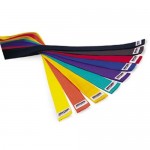 Macho Rank Karate Belts |
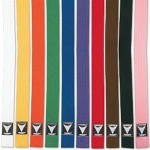 ProForce Thunder Solid Double Wrap Karate Belts |
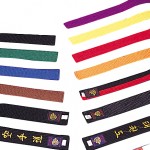 GTMA Color Karate Belts |
If you have any questions about selecting your uniform, please post them in the comment section below and we can keep a running Q&A for others to benefit from as well.



